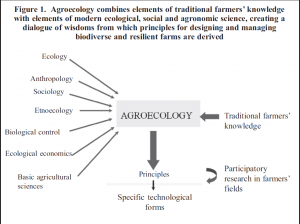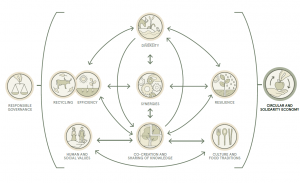Maria Schnyder
The Green Revolution has failed us. It was built on three assumptions: that there would always be abundant and cheap energy, that the water would never be scarce and that the climate would always be the same. But now, we know better. We know that we cannot rely on fossil fuels forever to keep machines going, that the unsustainable water consumption will get us into some serious trouble in the future and that climate change is a threat that cannot be neglected. While industrial agriculture promises us that it is going to solve those problems by more production, further research into genetic engineering and better technology, it might be beneficial to take a step back and have a look at the whole system that has established over the last decades. What if there was a solution that would not only ensure food security, but also be resilient to climate change, protect the environment while simultaneously creating sustainable economy? Too good to be true, right? Well, let me introduce you to the principles of agroecology.
What is agroecology?
Agroecology is in strict terms the use of ecology as a science in agricultural systems. This term is not new, it appeared in the 1920s in the literature, but only recently gained more attention in international and UN institutions. Its main goal is to develop a structure that is not dependent on external inputs, it rather relies on the species interaction within species and between species (FAO, 2019). In doing so, agroecology tries to mimic natural ecosystems with all its components, notably inter-dependency, self-regulation, self-renewal, self-sufficiency, efficiency and diversity (Altieri, 2015).
In a larger setting, it is a movement that connects social and economic principles to ecological concepts. As a bottom-up approach, agroecology seeks to solve local problems rather than imposing a one-size-fits-all-model. It wants to address the root causes of agricultural, societal and economical problems rather than only treating symptoms, and therefore seeks long-term solutions. Agroecology combines modern science with traditional, practical, observational based knowledge of producers (Altieri, 2015).

Figure 1:Agroecology combines elements of traditional farmers’ knowledge with modern science
Why do we need agroecology?
Industrial Agriculture has taken over during the last century. 90 percent of all agricultural land is dominated by monocultures which are dependent on energy and other external inputs. Not only is this resource-intensive but also the cause of massive deforestations, water scarcities, the loss of biodiversity, soil depletion and high levels of greenhouse gas emissions, contributing therefore significantly to climate change (FAO, 2019). And all this while only producing about 30 percent of the food we eat and using 70-80 percent of all arable land, 70 percent of water and 80 percent of fossil fuels in agriculture (Altieri, 2015).
About a third of the food produced by industrial agriculture is lost in production, transport, or simply thrown away, while more than a third of global grain supply is fed to animals. The food system is nowadays controlled by a small group of multinational corporations who believe in a productivist approach, promising to double food production by 2030. They are promoting genetically modified or engineered crops to solve the problem. But the top four genetically modified crops (soy, cotton, corn and canola) are largely used for agrofuels, animal feed or cash crops (Altieri, 2015). The claim that genetically modified/engineered crops are necessary to beat hunger is simply wrong. We grow enough food to feed all humans on earth, but despite of significant progress in recent times, extreme poverty and hunger still exist. Hunger is more related to inequality than production (FAO, 2019).
Genetic engineering has also been praised as a solution for malnutrition, as it might be possible to enrich plants with certain micronutrients. Golden rice, for example, is presented as the scientific solution to address vitamin A deficiency in developing countries. By activating an enzyme that produces beta carotene (precursor to vitamin A), scientists were able to improve the nutritional level of rice. However, one of the reasons for the deficiency in those countries is the establishment of industrial agriculture replacing traditional rice farms which had previously provided not only rice, but also fruits and vegetables rich in vitamin A (Altieri, 2015).
The world this industry has created depends nowadays mostly on 12 types of grains and 23 species of vegetables, a lot of them grown in monocultures. These monocultures are threatened by pests, disease and climate change, as the crops are more and more genetically uniform. It is much easier for pests to find plants when they are grown in monocultures. More pests call for more pesticides, which leads to greater loss in biodiversity, health risks and water pollution among many other consequences. Each day, thousands of species are facing extinction. Deforestation, climate change and soil erosion put natural systems under enormous amounts of stress. There is not enough water to maintain current water consumption levels. Just as an example, the beef industry uses 15’000 litres of water per kilogram, while cereals use 1500, and fruits 1000 litres per kilogram. Current industrial animal agriculture is the leading driver of ocean dead zones, as nitrogen and phosphorus get into rivers, eventually into the ocean. Those inputs promote algae growth that use up all the oxygen in the water (Altieri, 2015).
The environmental impact of industrial farming systems also takes a toll on human health. It is the cause of about 90 percent of Europe’s ammonia emissions. Those are closely linked to air pollution, killing 400’000 Europeans each year. Another hazard is antimicrobial resistance, as well as the exposure to chemicals interfering with the human endocrine system and pesticides that can enter the human body via foods, its packaging and the contamination of water sources (De Schutter, 2019).
Additionally, socio-economic impacts have to be considered. There are major power imbalances in the agricultural industry. On one hand, many farmers and producers are working under poor conditions and fight for their existence, and on the other hand, 70 percent of the global agrochemical industry in owned by only three companies, and up to 90 percent of the global grain trade is in the hands of only four multinationals. Obviously, those big players set prices and therefore have a massive influence working conditions. Farmers have higher input costs while the food chain value drops, which has lead to the disappearance of about a quarter of all farms in Europe alone (De Schutter, 2019).
Future agricultural systems need to be independent from fossil fuels, have low environmental impacts, be multifunctional, resilient to extreme events, be the foundation for local food production systems while including local innovations. Current industrial agriculture focusses on the limiting factors of plant growth like water or nutrients. However, limiting factors are nothing but symptoms of a deep ecological dysfunction and attacking the symptoms only creates more problems. When one limiting factor is under control, another one appears. Agroecology focusses on the root cause rather than the symptoms, not only in the ecological, but also in the socio-economic context (Altieri, 2015).
How can Agroecology contribute to the SDGs?
The Food and Agriculture Organization of the United Nations (FAO) has established ten principles of Agroecology to provide a guideline for policymakers, stakeholders and practitioners to implement a sustainable way of growing food. Those principles are diversity, co-creation and sharing of knowledge, synergies, efficiency, recycling, resilience, human and social values, cultural and food traditions, responsible governance and lastly, circular and solidarity economy. The illustration below shows the connections between the principles very well. Ecological and social concepts at the core, embedded in a functioning economical frame (FAO, 2019).

Figure 2: The ten principles of Agroecology
Through its socioeconomical approach, agroecology tries to ensure the access to healthy, nutritious food for everyone, especially for poor and people in vulnerable situations. The diversity of plant foods like cereals, fruits, vegetables, legumes, nuts and seeds provides a variety of macro- and micronutrients. Agroecology therefore is more than suitable to achieve the second SDG that wants to end hunger, achieve food security and improved nutrition and promote sustainable agriculture. Agroecology seems to be exactly the farming system the UN is trying to implement (IAEG-SDGs, 2016a). It improves land and soil quality through various factors like diversity and recycling of nutrients, it is resilient to external shocks and it can produce enough food to feed all humans. By sharing of knowledge between various stakeholders at different levels, agroecology takes an inclusive approach to create a system where everyone can get involved. Responsible Governance is needed to support agriculture at all stages and levels.
By contributing to the access to healthier food, agroecology tackles also the third SDG that focuses on health and well-being at all ages (IAEG-SDGs, 2016b). In eliminating the use of chemical fertilizers and pesticides, agroecology reduces significantly the impact of agriculture on the environment, which leads to less hazardous chemicals and air, water and soil pollution and contamination and eventually reduces the number of illness and death.
The principle of efficiency in agroecology applies to the increase in production while using fewer external resources and rather relying on abundant natural resources like solar radiation, atmospheric carbon and nitrogen. Agroecology therefore installs sustainable consumption and production patterns, contributing to SDGs 6 (sustainable water management) and 12 (responsible consumption and production) (IAEG-SDGs, 2016c).
So, now what?
Growing food the way we do it now has become a massive burden for the environment and for the people involved. The current system has gigantic flaws, and for the most part, industrial agriculture just tries to cure the symptoms. In doing so, the illness is not conquered, it is still there. And if we don’t try to reach root cause, this illness spreads and gets worse and worse. The time is now to change the system.
Agroecology appears to be the best solution we currently have to not only protect the environment, but also protect and improve the livelihoods of the people producing food. It seems to be a mammoth task to shift from industrial farming to agroecology. And it is. But it is a long-term change towards a sustainable future.
References:
Altieri, M. (2015). Agroecology: Key Concepts, Principles and Practices
De Schutter, O. (2019). Towards a common food policy for the European Union; The policy reform and realignment that is required to build sustainable food systems in Europe: IPES. Abgerufen von: http://www.ipes-food.org/pages/CommonFoodPolicy
FAO. (2019). The 10 Elements of Agroecology. Zugriff am 7.4.2020. Abgerufen von http://www.fao.org/agroecology/knowledge/10-elements/en/.
IAEG-SDGs. (2016a). Sustainable Development Goal 2. Zugriff am 8.4.2020. Abgerufen von https://sustainabledevelopment.un.org/sdg2.
IAEG-SDGs. (2016b). Sustainable Development Goal 3. Zugriff am 8.4.2020. Abgerufen von https://sustainabledevelopment.un.org/sdg3.
IAEG-SDGs. (2016c). Sustainable Development Goals. Zugriff am 8.4.2020. Abgerufen von https://sustainabledevelopment.un.org/sdgs.
List of figures:
Figure 1: Altieri, M. (2015). Agroecology: Key Concepts, Principles and Practices
Figure 2: FAO. (2019). The 10 Elements of Agroecology. Zugriff am 7.4.2020. Abgerufen von http://www.fao.org/agroecology/knowledge/10-elements/en/.
Media Attributions
- Agroecology
- FAO